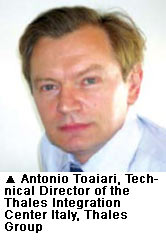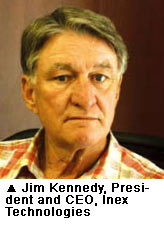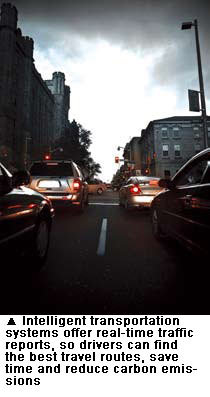Intelligent transportation systems offer benefits along with complexities. A&S takes a look at how problems integrating IP and analog are being resolved.
Intelligent transportation systems offer benefits along with complexities. A&S takes a look at how problems integrating IP and analog are being resolved.
There are several reasons why intelligent transportation systems are being deployed. On the road, they offer up-to-the-minute traffic reports and find available parking. With real-time updates, drivers can select the best travel routes, save fuel and minimize emissions. Most importantly, smart traffic solutions improve driver safety and can save lives. New products and systems provide better scalability, reliability and cost-to-benefit ratios.
Intelligent traffic systems are complex, said Antonio Toaiari, Technical Director of the Thales Integration Center Italy, Thales Group. They include detection and measurement of traffic along major roads, along with remote control and setting of traffic light cycles. Notification is another requirement, providing information for drivers on traffic conditions, parking areas (public information displays) and alternative routes. They also must monitor environmental conditions, view real-time conditions and trigger alarms. Thales has developed a set of solutions for transportation, security and automation, with projects all over the world.
"These systems are being integrated and managed by a central management and control platform that allows operators to engage in real-time interventions according to real-time conditions," Toaiari said. When building traffic management systems, he stressed municipalities must consider previous investments which were installed earlier. "Their integration in the new scenario is a challenging task for system integrators."
That task will become lighter.
Inex Technologies has experience with analog systems for ALPR systems, said President and CEO Jim Kennedy. Until recently, the camera essentially was an analog device.
"Once we take the image into our processor, the license plate image is digitized and, from that point on, the system is no longer analog," Kennedy said. "Often, the processor is located near the camera, so the role played by any analog technology within the system is minimal. Now we have migrated to digital ALPR cameras and the small portion of remaining analog technology has been completely eliminated."
It is his view that development or integration problems do not enter the picture with APLR systems. "The point where we deliver the results — the license plate read and associated images — are already in a digital format," Kennedy said.
Standards
Standards are key to intelligent transportation systems. Increasingly, 5.9 GHz  DSRC technology looks set to replace 915 MHz DSRC in the U.S. and 5.8 GHz DSRC in Europe, as it delivers standardized intelligent traffic products for large deployments. Improved and cost-effective communication capabilities enable the technology to support uses in vehicle, public-safety and commercial applications.
DSRC technology looks set to replace 915 MHz DSRC in the U.S. and 5.8 GHz DSRC in Europe, as it delivers standardized intelligent traffic products for large deployments. Improved and cost-effective communication capabilities enable the technology to support uses in vehicle, public-safety and commercial applications.
Another transmission standard is continuous air-interface, long and medium range, which delivers wide-area communications. This performs well on a number of different network platforms, including 2-G, 3-G and 4-G, as well as satellite, microwave, millimeter-wave, IR, Wi-Max and Wi-Fi.
Some users experience difficulty with wireless networks. A dedicated network is required, to prevent the traffic transmission system from overloading.
Scalability
The large number of video devices makes scalability a requirement for intelligent traffic systems. Some experts feel the real issue is system architecture from the edge to the central monitoring station. "If you consider that the system is already digital after the processor stage, than there is little difference," Kennedy said. "If, on the other hand, someone designed the system so that all video came to a central site unprocessed, then you have a different challenge." Bringing standard-based video to a central site requires substantial bandwidth for each camera, either by wireless or a fiber optic network. "Of course, digital cameras can be networked, and such networks will not have nearly the bandwidth requirements of analog video streams," Kennedy said.
In Toairi's experience, most existing city surveillance cameras are analog, connected to video management software through video encoders. "Normally, this has had an impact on the network connecting the various field components," he said. "It is up to the system integrator to offer a better solution by adapting the existing system or deciding to replace it."
Thales has developed a flexible video management system that integrates a video processing algorithm. "Adapting the architecture to specific projects is easy, thanks to the functions and configuration management tools," Toairi said. The system provides support in emergency conditions and operating procedures can be configured.
Fiber Optics
Fiber backbones are expensive and each project has to be examined to justify the  cost, Kennedy said. As ALPR is used for generating revenue or capturing lost revenues from toll violators and speeders, the difficulty lies in public acceptance. Traffic monitoring technologies are considered an infringement on personal liberties or designed to extract money for questionable reasons.
cost, Kennedy said. As ALPR is used for generating revenue or capturing lost revenues from toll violators and speeders, the difficulty lies in public acceptance. Traffic monitoring technologies are considered an infringement on personal liberties or designed to extract money for questionable reasons.
Thales has been working with fiber options since the early 1980s, enabling the best performance when it comes to data transmission. "The global cost of the technology is considerably decreased compared with the beginning," Toairi said. "It cannot, however, be justified when considering the associated civil work and infrastructure, if the potential of these two is not developed or planned to be developed in the future."
In certain scenarios, fiber optics is mandatory to assure service quality and reliability. "A way to decrease the payback time is to deliver added value and mission-critical services, while sharing transmission bandwidth among various operators," Toairi said.
Reliability
"We are known for delivering solid license plate images and data at any vehicle speed, at any time of day and in any climate," Kennedy said. In his opinion, a good ALPR supplier will not have a problem with low-light environments because "dealing with low light is part of what we do; the same can be said for environmental and climatic situations."
Kennedy is not aware of any APLR suppliers that work only on projects with specific conditions, say indoors, vehicles traveling at less than 50 miles per hour or during the day. "If there are such suppliers, they won't last long in the current arena where requirements for ALPR equipment are very high and are being met," he said.
However, analytics are notorious for false alarms. An Asian metropolis deployed an intelligent video solution, only to abandon it for manned monitoring that was deemed more effective. More standards in analytics and better customization are needed for demanding outdoor traffic applications, before intelligent video can be deployed further.
The market offers a range of equipment designed for reliability and performance, which comply with environmental requirements and operative scenarios, Toairi said.
Operating conditions in cities are less challenging than harsh industrial environments, such as the petrochemical sector or combat operations. "Thales has also developed wireless solutions for applications in harsh and safety related contexts," Toairi said. "Sometimes, though, available budgets challenge the system integrator in finding solutions to fit the requirements."
Accurate LPR
A Bosch solution uses technology gained from free-flow ALPR. "It offers a flexible, simplified license plate recognition solution for private roads, tolling, car parks,  gated communities and secure business premises," said Jan Noten, Application & Business Development Specialist for Digital CCTV, Bosch Security Systems.
gated communities and secure business premises," said Jan Noten, Application & Business Development Specialist for Digital CCTV, Bosch Security Systems.
Using high-contrast license plate imaging provided by dedicated ALPR cameras, the system compares characters found in plate images with its preloaded font library. This allows it to determine the exact characters on the license plate and its country of origin.
The system's microprocessor compares this information with a user-specified white/black list to determine if entry or exit is allowed. "These Bosch cameras produce images that are unlike those of standard CCTV cameras, comprising white boxes containing license plate characters set against a black background," Noten said. "The cameras do this by removing all ambient light sources, such as headlights and sunlight glare, through optical filtering techniques and images using only the illumination that they put onto the scenes."
Uncluttered, high-contrast images make it simple for any ALPR software system to find and process important data. "The result is significantly improved accuracy rate rates and more reliable ALPR," Noten said.
Clear Tunnel Vision
Lighting challenges in tunnels are being successfully addressed. At road tunnel entrances and exits, light levels change from daylight — as high as 100,000 lux — to the relative gloom of the tunnel's artificially lit interior. "This places severe demands on cameras deployed in these areas, particularly with regard to sensitivity and dynamic range," said Ad Biemans, Product Marketing Manager for CCTV, Bosch Security Systems.
A Bosch camera combines a 15-bit DSP with a high-speed positioning system to  overcome this issues. "Bosch has made use of the power of its DSP to accentuate details in a scene that would otherwise be lost," Biemans said.
overcome this issues. "Bosch has made use of the power of its DSP to accentuate details in a scene that would otherwise be lost," Biemans said.
A proprietary feature, known as XF-Dynamic, uses histogram equalization to enlarge image details by amplifying tiny variations in illumination. "The XF-Dynamic provides a 32-fold increase in dynamic range compared with a standard camera, which means that scenes remain clearly visible even if bright shafts of sunlight penetrate the interior of the tunnel," Biemans said.
The advanced processing power of the camera's DSP provides improvements in contrast and increases dynamic range through the camera's proprietary auto black function. By dynamically stretching illumination levels in scenes to reduce darkest areas to (near) black, auto black enhances contrast in color pictures obscured by exhaust fumes or smoke in a tunnel.
"The auto black function, previously found only in black-white cameras, results in significant improvements in visibility, enabling control room operators to continue monitoring traffic even in the event of a tunnel fire," Biemans said.
The camera combats motion blur by combining features to maintain optimal performance even if the lights go out. "The camera can be switched into default shutter mode," said Biemans. "This is sufficient to capture vehicle registration plates without motion blur."